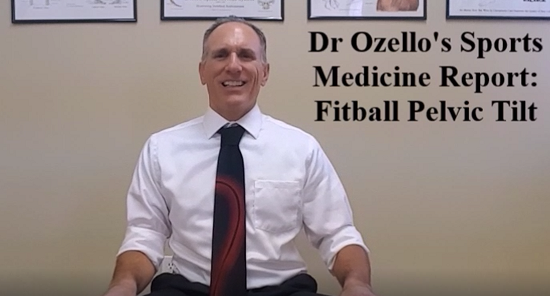The large exercise ball, known as the fitball, has many valuable uses. In this article, I will use the name fitball to eliminate confusion. One of the most beneficial effects of the fitball is for spine health, especially the intervertebral disc.
The intervertebral disc (IVD) is located in between vertebrae. The disc works by distributing shock throughout the vertebral body. It has a gel-like filled nucleus and a tough fibrous outer lining.
Most serious back injuries involve the intervertebral disc. The disc may bulge or herniate leading to impingement upon the spinal cord or a spinal nerve root. A pinched nerve can elicit symptoms such as sharp pain, weakness, numbness or burning along the course of the nerve.
Athletes and non-athletes have suffered injuries to their intervertebral discs. Some of the more serious disc conditions have been career threatening or career ending.
Direct blood flow to the intervertebral disc ceases around the age of six. After this the disc receives its nourishment through osmosis from the vertebrae above it and below it. Motion is the best tool to keep the osmotic process working steadily and the disc healthy.
As we age the intervertebral disc slowly starts to dehydrate and shrink in height. Many senior’s spinal x-rays display reduced disc space.
Slight bouncing exercises on the fitball are ideal for keeping the disc nourished. These slight bouncing motions strengthen the core muscles and bring fluid into the disc. The fitball is an essential tool for spinal health and motion.
The fitball is a large inflatable ball than ranges from 45cm to 85 cm in diameter. The fitball is known by many names including the exercise ball, ab ball, abdominal ball, Swiss ball, stability ball, therapy ball, balance ball, Pilates ball, yoga ball, fitness ball, rehab ball & gymball.
It is imperative that you choose the ball that is appropriate for your height. The general guidelines for the sizing are:
45 cm fitballs are recommended if you are less than 5’0.’’
55 cm balls are recommended for those between 5 foot and 5’5.”
65 cm fitballs should be used by individuals between 5’6’ and 6’1.”
75 cm fitball are recommended for people between 6’2” and 6’8.”
Persons above the height of 6’8” generally need the 85 cm fitball.
You may require a slightly bigger ball for your height if you have a pre-existing spine condition or have very long legs.
Holding the pelvic tilt position will strengthen the core muscles and ensure proper technique. Maintain the pelvic tilt position throughout the entire exercise and use a normal breathing pattern.
While bouncing and holding a pelvic tilt, slowly start to shift your hips to the right. Go as far as you can to the right, return to the center and proceed as far as you can to the left. Perform several repetitions in each direction in a slow controlled manner.
Exercise technique is vital, concentrate on maintaining proper posture.
Once you have mastered the shift to the right and to the left you can progress to making small squares in each direction, small circles in each direction and figure-eights in each direction. These motions will strengthen the abdominal muscles at a wide range of angles and bring nourishment to the intervertebral disc.
Execute these simple but effective fitball motion exercises to keep your intervertebral disc healthy and strong for your lifetime. Begin at an appropriate level for you. Many individuals have started by simply sitting on the fitball in proper posture while holding a pelvic tilt to build strength and endurance in the core muscles. This is a great place to start. Advance to the directional hip shift at a pace that is comfortable for you.
Spinal health is essential to our overall health, fitness and functionality. Do yourself a huge favor and include these simple but effective fitball exercises in your lifelong exercise strategies.
Dr Donald A Ozello DC of Championship Chiropractic in Las Vegas, NV
Web Site: http://www.championshipchiropractic.com/
Blog: https://www.championshipchiropractic.com/wordpress/
YouTube: https://www.youtube.com/user/drdozellodc/videos
Twitter: https://twitter.com/drdozellodc
Facebook: https://www.facebook.com/Championship-Chiropractic-280141628688300/
LinkedIn: https://www.linkedin.com/in/dr-donald-a-ozello-dc-716b3233
“Running: Maximize Performance & Minimize Injuries” https://www.amazon.com/Running-Performance-Chiropractors-Minimizing-Potential/dp/1493618741
**Disclaimer: Always consult a medical professional before beginning an exercise program. Always work within your capabilities. Never perform an exercise that elicits or increases pain or symptoms. Reading this article and viewing the linked videos does not take the place of seeing a medical professional. Please visit a medical professional for evaluation, diagnosis & treatment.

